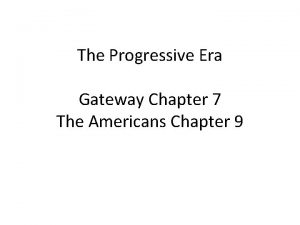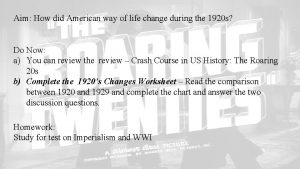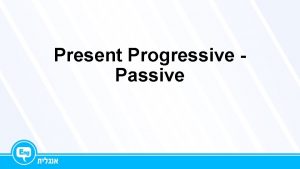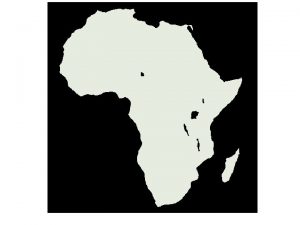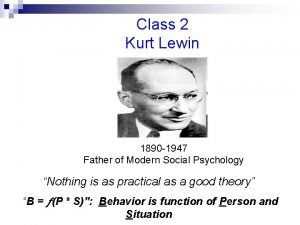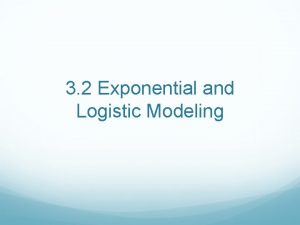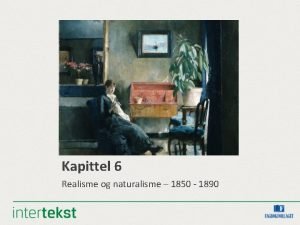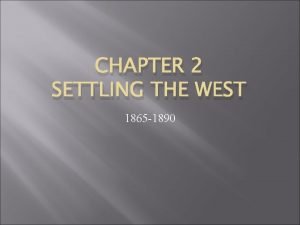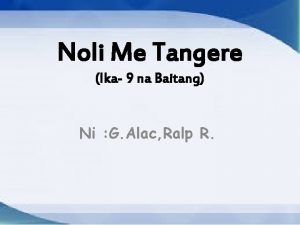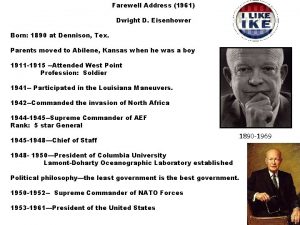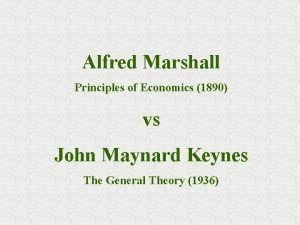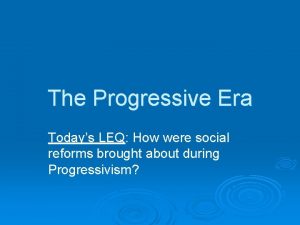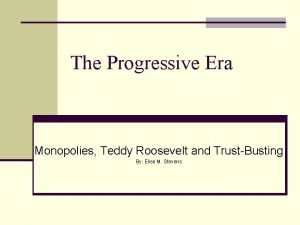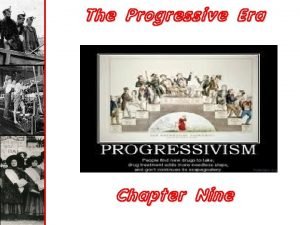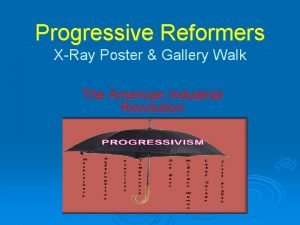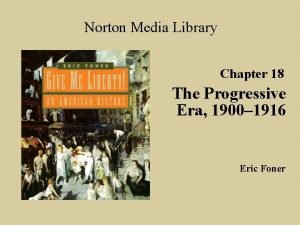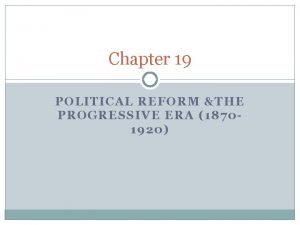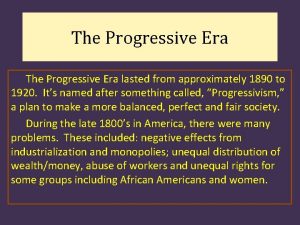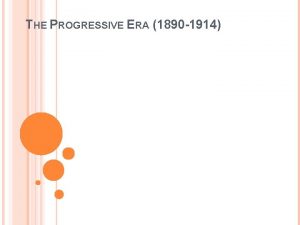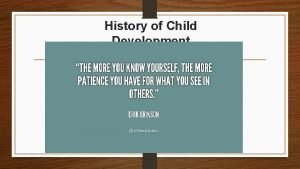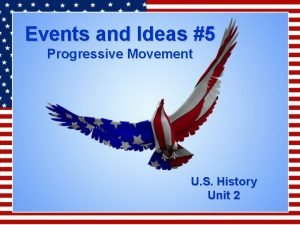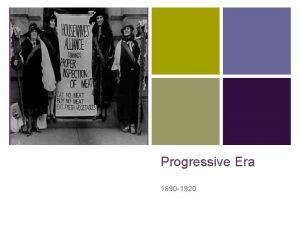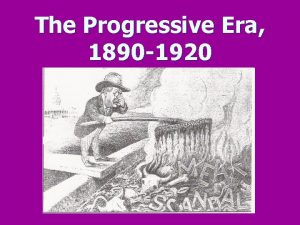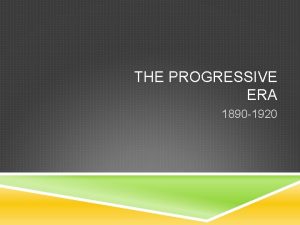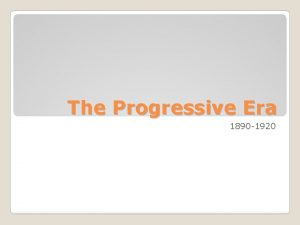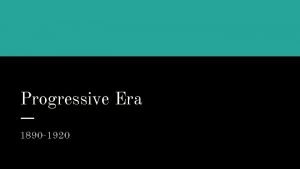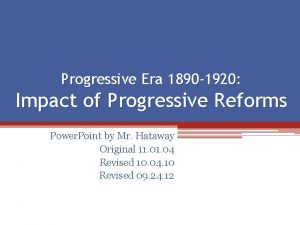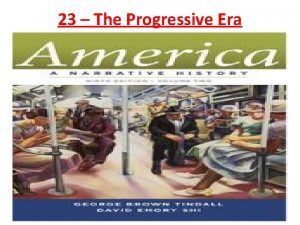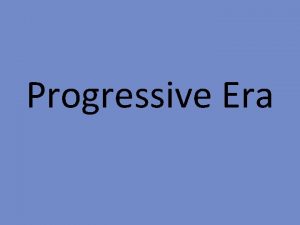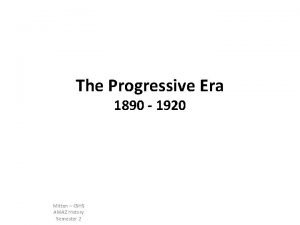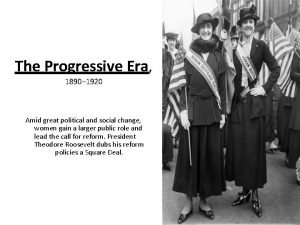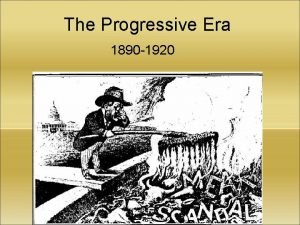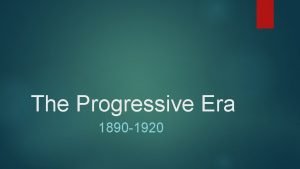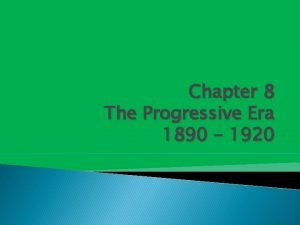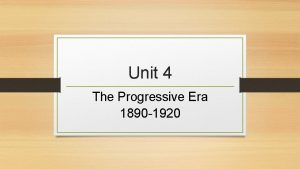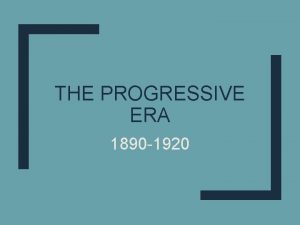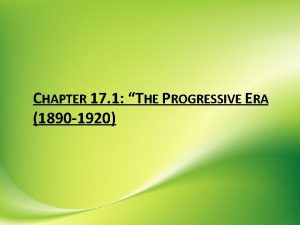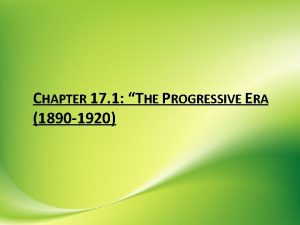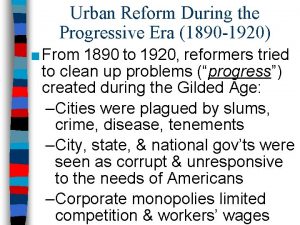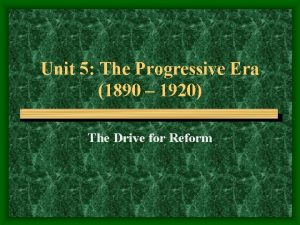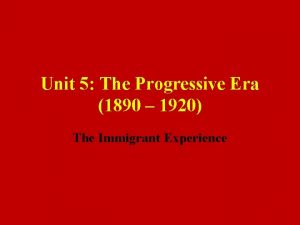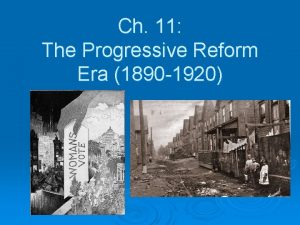American History The Progressive Era 1890 1920 All


































- Slides: 34

American History The Progressive Era (1890– 1920) All photographs courtesy of The Library of Congress & Lewis Hine Owl. Teacher. com

Questions to Answer • Which President was known as the Progressive President? • How did the Bull Moose Party help Woodrow Wilson win the 1912 election? • How did the Progressive movement slow down ending segregation? Owl. Teacher. com

The Origins of Progressivism • Rapid industrialization, immigration, and urbanization in the late 1800 s led to national growth and prosperity. Owl. Teacher. com

• The rapid growth also caused poverty, unemployment, horrible working conditions and political corruption. • Many Progressives believed that political action and reform, not private charities, were the methods to bring about progress in society. Owl. Teacher. com

• Historians call the period from about 1890– 1920 the Progressive Era. Owl. Teacher. com

Dakota Apartment House, ca. 1905 -1915 Owl. Teacher. com

A Monday Afternoon Washing, 107 th Street, 1900 Owl. Teacher. com

Family in Attic Home, Drying Their Laundry, ca. 1900 -1910 Owl. Teacher. com

The Progressives: Their Goals and Beliefs § Progressives were not a single unified movement. § They fell into four categories: 1. 2. 3. 4. Owl. Teacher. com Social Moral Economic Political

Some common basic beliefs were: 1. Government should be more accountable to its citizens. 2. Government should curb the power and influence of wealthy interests. 3. Government should be given expanded powers so that it could become more active in improving the lives of its citizens. 4. Governments should become more efficient and less corrupt so that they could Owl. Teacher. competently handle an expanded role.

Igniting Reform: Writers and Their New Ideas • The ideas of many writers and journalists influenced public opinion about how to reform society. • Journalists investigated and publicized conditions in certain industries, slums, tenement houses, and sweat shops. Owl. Teacher. com

President Teddy Roosevelt Republican Teddy Roosevelt took over when President Mc. Kinley was killed. Was a progressive and made very progressive policies. Roosevelt Wanted: Owl. Teacher. com 1. 2. 3. 4. 5. 6. 7. business regulation welfare laws workplace protection for women Child labor laws Income minimums inheritance taxes voting reform.

• Theodore Roosevelt called the journalists “muckrakers. ” • Upton Sinclair, Lincoln Steffens, and Ida Tarbell were respected writers and muckrakers. Owl. Teacher. com

Progressive Reform Organizations The Labor Employers discouraged union membership. Courts often issued injunctions which are Movement court preventing workers from going on strike. Unions continued to fight for better working conditions. Socialists The Progressive Era saw a rise in socialism. They hoped to end the capitalist system and distribute wealth more equally. Women’s Groups The National Consumers’ League (NCL) investigated how goods were made and sold. They discouraged people from buying from shops that employed child labor. Owl. Teacher. com

An Expanded Role for Government • Progressives sought more social welfare programs to help ensure a minimum standard of living. • Many of the earliest Progressive reforms were made at the municipal, or city, level. Owl. Teacher. com

Taft’s Presidency • Taft was endorsed by Roosevelt and pledged to carry on the progressive program. • However, he did not even appoint any Progressives to his Cabinet. • Taft also angered conservationists on the issue of public land management. Owl. Teacher. com

• Taft sided with business interests who sought unrestricted development of public lands. • Taft angered many people and his presidency suffered. Owl. Teacher. com

Turmoil in the Republican Party • Angry Republican Progressives teamed up with Democrats. • Roosevelt criticized Taft and campaigned for Progressive candidates in the 1910 midterm elections. Owl. Teacher. com

• Teddy’s new plan for the country was called. New Nationalism. Owl. Teacher. com

• Progressive Republicans left the Republican Party and formed the Bull Moose Party. • The Bull Moose platform included tariff reduction, woman’s suffrage, more regulation of business, a child labor ban, an eight-hour workday, and direct election of senators. Owl. Teacher. com

The Election of 1912 A Four-Way Election William Howard Fought to keep the Presidency for the Taft Republican Party Theodore Roosevelt Represented the Progressive Bull Moose Party Eugene V. Debs Made his third of five presidential runs for the Socialist Party Woodrow Wilson Headed the Democratic ticket; with the Republican Party split between Taft and Roosevelt, Wilson won the election. Owl. Teacher. com

Wilson’s Policies as President • He attacked the trusts by helping Congress pass the Clayton Antitrust Act in 1914. • Wilson and Congress created the Federal Trade Commission to enforce the Clayton Antitrust Act. Owl. Teacher. com

• In 1913 Congress passed the Federal Reserve Act and created the Federal Reserve System to overhaul the American banking system. • In 1916 Wilson tried to attract Progressive voters. • To this aim he nominated Progressive lawyer Louis D. Brandeis to the Supreme Court. • In 1916 Wilson won a second term. Owl. Teacher. com

The Limits of Progressivism • The changes made by Progressives were limited to certain groups in the United States. • Progressives championed city reforms, but did little for tenant or migrant farmers. • Progressive Presidents took little action to pursue social justice reforms. Owl. Teacher. com

No help for Segregation • Wilson continued the Jim Crow practice, begun under Taft, of separating the races in federal offices. • At the 1912 Progressive Party convention, Roosevelt declined to seat black delegates from the South for fear of alienating white Southern Progressives. • By 1916, the reform spirit had nearly died. • It was replaced by American concerns about World War I. Owl. Teacher. com

• Women had two approached to getting the vote – The National Woman Suffrage Association fought for a constitutional amendment for suffrage. – The American Woman Suffrage Association worked to win voting rights on the state level. Owl. Teacher. com

Preparing the Way for Suffrage • In 1890, Wyoming entered the union and became the first state to grant women the right to vote. • In 1872, in an act of civil disobedience, a suffrage leader, Susan B. Anthony, insisted on voting in Rochester, New York. • She was arrested for this act. Owl. Teacher. com

A New Generation • Susan B. Anthony and Elizabeth Cady Stanton, leaders of the suffrage movement, died without seeing the victory of women’s suffrage. • At the turn of the century, Carrie Chapman Catt became the leader of the National American Woman Suffrage Association (NAWSA). • She led the movement from 1900 to 1904 and again after 1915. Owl. Teacher. com

Victory for Suffrage • In 1918, Congress formally proposed the suffrage amendment. • After the amendment was proposed the ratification battle began. • In August 1920, Tennessee became the 36 th state necessary to ratify the suffrage amendment. • The Nineteenth Amendment, granting women the right to vote, was the last major reform of the Progressive Era. Owl. Teacher. com

Owl. Teacher. com

Owl. Teacher. com

Some boys and girls were so small they had to climb up on to the spinning frame to mend broken threads and to put back the empty bobbins. Owl. Teacher. com

Oyster shuckers working in a canning factory. All but the very smallest babies work. Began work at 3: 30 a. m. and expected to work until 5 p. m. The little girl in the center was working. Her Owl. Teacher. com mother said she is "a real help to me. "

Please Answer these Questions • Which President was known as the Progressive President? • How did the Bull Moose Party help Woodrow Wilson win the 1912 election? • How did the Progressive movement slow down ending segregation? Owl. Teacher. com
 Gateway to us history chapter 7 the progressive era
Gateway to us history chapter 7 the progressive era American way of life 1920
American way of life 1920 All wet slang
All wet slang The passive present progressive
The passive present progressive Past continuous past simple past perfect
Past continuous past simple past perfect Past perfect tense
Past perfect tense Opposite rays
Opposite rays New imperialism motives
New imperialism motives Kirjanik 1886-1971
Kirjanik 1886-1971 Agnosia associativa
Agnosia associativa Kurt lewin (1890-1947)
Kurt lewin (1890-1947) Penholder tutuşu
Penholder tutuşu The population of smallville in the year 1890 was 6250
The population of smallville in the year 1890 was 6250 Exponential functin
Exponential functin Naturalismen drama
Naturalismen drama 1890 computer
1890 computer Settling the west 1865 to 1890
Settling the west 1865 to 1890 Patrick royston
Patrick royston Importanteng kaganapan sa el filibusterismo noong 1887
Importanteng kaganapan sa el filibusterismo noong 1887 Kaalaman sa pagsulat
Kaalaman sa pagsulat Born 1890
Born 1890 Kaugnayan sa kaligirang pangkasaysayan ng el filibusterismo
Kaugnayan sa kaligirang pangkasaysayan ng el filibusterismo Keynes marshall
Keynes marshall Progressive era leq
Progressive era leq What is lincoln steffens known for
What is lincoln steffens known for Progressive era monopolies
Progressive era monopolies Progressive era dbq answers
Progressive era dbq answers Progressive era posters
Progressive era posters Chapter 18 the progressive era
Chapter 18 the progressive era Chapter 19 political reform and the progressive era
Chapter 19 political reform and the progressive era Paradigm shift in technology
Paradigm shift in technology The progressive era lasted from
The progressive era lasted from Promoting moral improvement
Promoting moral improvement John dewey progressive era
John dewey progressive era Progressive era worksheets
Progressive era worksheets
